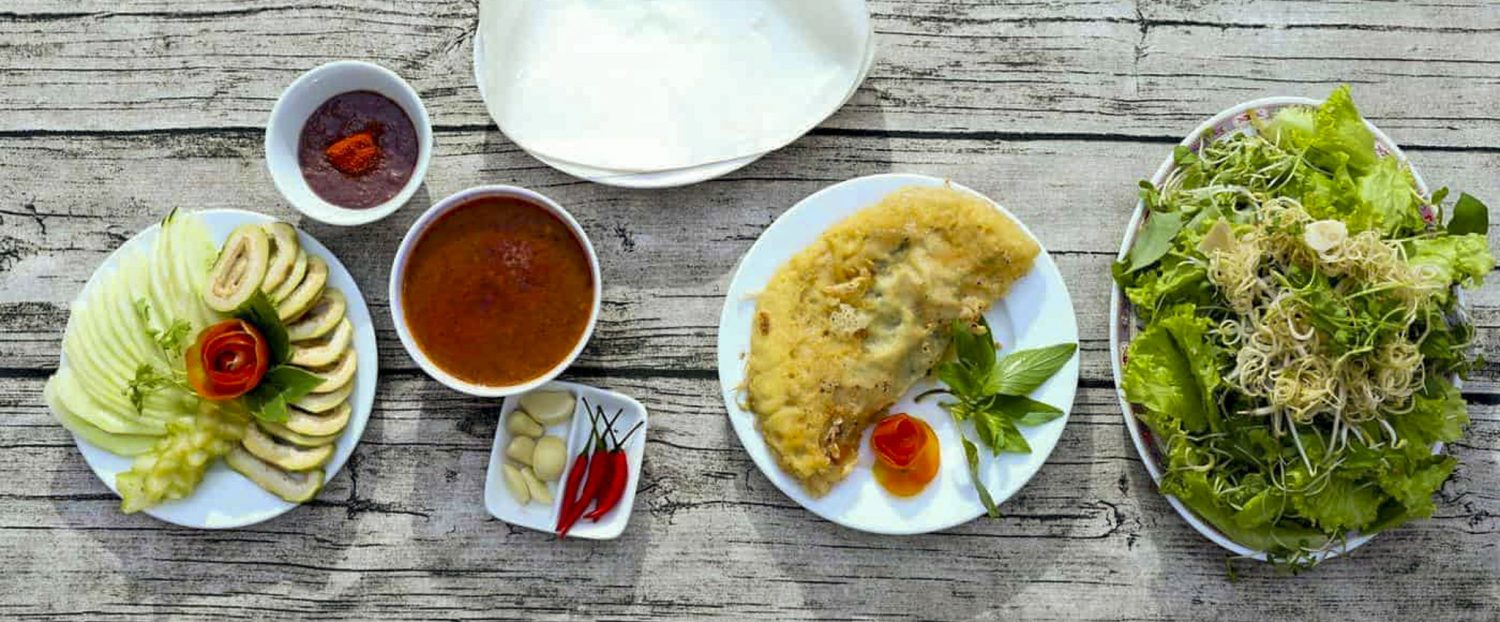Nestled in the heart of Vietnam, Quang Binh province is renowned not only for its breathtaking landscapes but also for its unique and flavorful cuisine. The local specialties reflect the region’s rich cultural heritage and the abundant natural resources of its land and sea. From savory dishes bursting with traditional spices to sweet treats that capture the essence of rural life, Quang Binh offers a culinary journey that delights every palate. This article will explore the top 10 must-try specialties in Quang Binh, ensuring your journey is as flavorful as it is unforgettable. Get ready to indulge in the best of Quang Binh’s culinary delights!
Quang Binh cuisine: The quintessence of Central Vietnamese cuisine
Located in Central Vietnam, between Thanh Hoa and Quang Tri provinces, Quang Binh boasts a unique geographical position, bordering Laos and the East Sea. This not only helps Quang Binh have a diverse natural environment with mountains, forests, rivers, and seas but also turns this land into a place where local culture and cuisine intersect. It is no coincidence that this place has an extremely rich culinary background, making choosing the best dishes a controversial issue.
However, after careful selection and research, this article has gathered the top 10 famous dishes that visitors must try when coming to Quang Binh. Each dish is characterized by unique, sophisticated preparation methods and a harmonious blend of spices that reflect the distinct flavors of Central Vietnam.
Land, climate, and natural environment play a crucial role in creating the renowned specialties of Quang Binh. Situated along the coast and featuring a network of rivers, the region boasts a rich and fresh variety of seafood ingredients, such as fish, shrimp, crab, clams, etc. Additionally, with its abundant mountainous areas, Quang Binh is home to many unique herbs and vegetables. Despite enduring seasonal floods and facing many challenges in agriculture, the ingenuity of the local people has led to the creation of numerous specialty dishes from simple ingredients. These dishes provide visitors with the opportunity to experience the unique flavors of the local cuisine.
Specialties you must try or take home as gifts from Quang Binh
Quang Binh is widely known to visitors for its many famous scenic spots. However, this land is also home to numerous enticing specialties. Below is a list of Quang Binh’s renowned specialties that travelers should not miss:
Quang Hoa pancakes (Bánh xèo Quảng Hòa)
Quang Hoa pancakes are a simple, rustic dish that carries the rich and unforgettable flavors of the Quang Binh countryside. It originates from Quang Hoa Commune, Ba Don Town, Quang Binh Province.
The main ingredient for making Quang Hoa pancakes (bánh xèo) is red brown rice. The rice is soaked in water for 3–5 hours before being finely ground. Salt and finely chopped scallions or chives are added to the mixture and thoroughly blended. The Quang Hoa pancake mold, made of cast iron or steel, is round with a diameter of about 15 cm and a height of 1.5 cm. It is placed on a charcoal stove, and once hot, a ladle of the rice batter is spread onto the mold. In just 30 seconds, a thin, hot pancake is ready. Tiny bubbles appear as the batter sizzles, with the chopped scallions or chives evenly scattered on the surface. This method of cooking gives the bottom of the pancake a slight crispiness, while the top remains soft and chewy.
Quang Hoa pancakes are typically served with banana fish, salad, fresh herbs, and dipping sauce. The banana fish here refers to green banana fruit that is finely sliced, boiled, and then shaped into a fish, creating an attractive appearance. The salad is made from bean sprouts, cabbage, toasted sesame, and fresh herbs such as lettuce, cucumber, and aromatic greens. The dipping sauce for the pancakes is a sweet and sour sauce, made from garlic, chili, sugar, lime, and other ingredients.
The pancakes are crispy on the outside, soft and smooth on the inside, and when combined with the rich flavor of the banana fish, the refreshing salad, and the sweet and sour dipping sauce, they create a delicious and unforgettable dish.
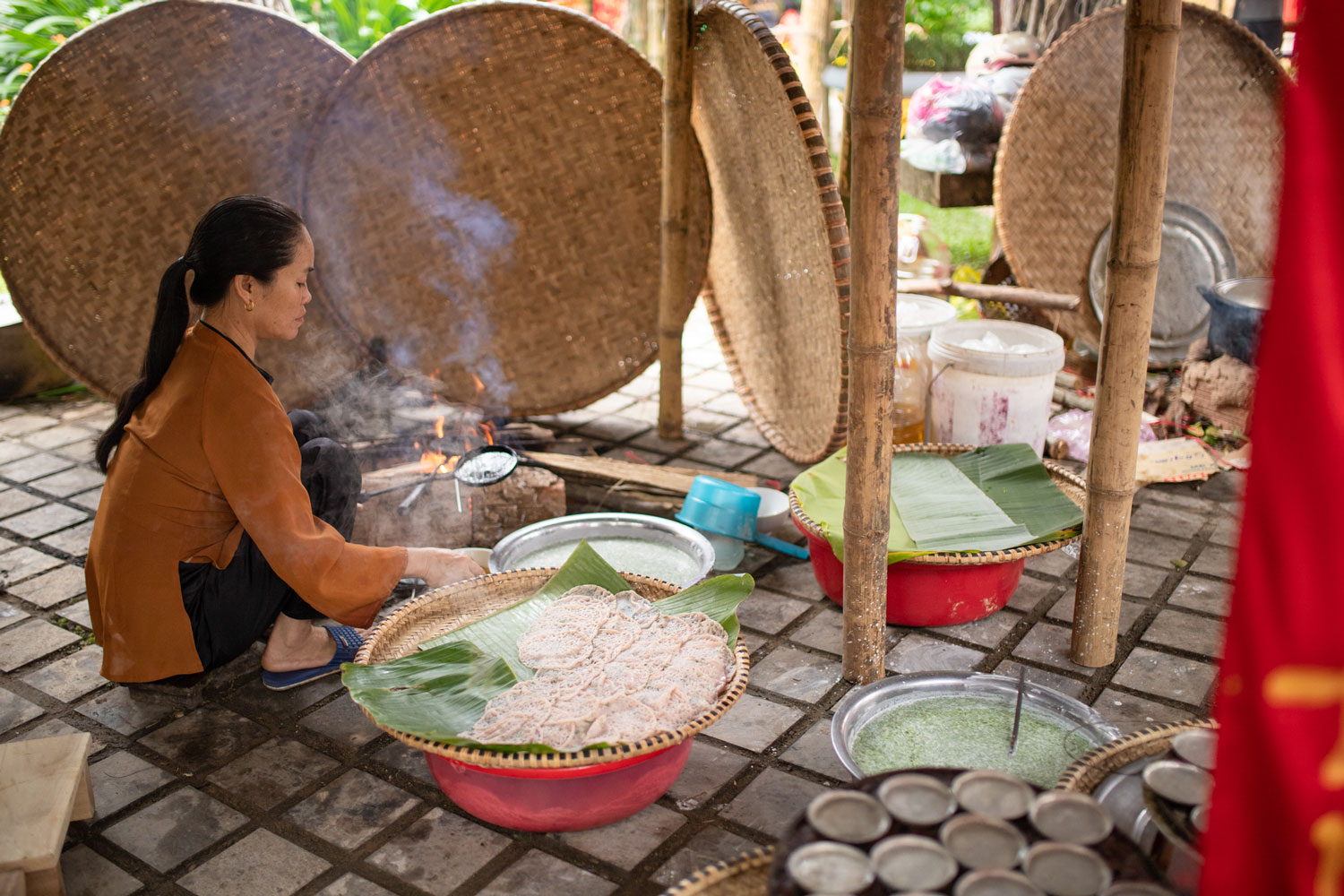
Fish cake noodle soup (Cháo canh)
Fish cake noodle soup is a simple dish popular in many regions of Vietnam. However, its distinct flavor leaves a lasting impression on anyone who tries it. The noodles are made from rice or wheat flour, kneaded, and cut into small, soft, chewy strands of light yellow color. They must be handmade and of moderate thickness—not too hard or too soft.
The soul of this dish is the broth that is usually simmered from pork bones, chicken bones, or fish bones. The bones are cleaned, cut into bite-sized pieces, and then simmered for several hours until they become tender. During the simmering process, it is important to skim off the foam to keep the broth clear frequently. Once the bones are soft, seasonings such as salt, seasoning powder, monosodium glutamate, and pepper are added to adjust the flavor of the broth.
The accompanying ingredients for Chao Canh are also very diverse, depending on individual preferences. Typically, Chao Canh can be served with fish cakes (chả cá), Vietnamese pork sausage (chả lụa), shrimp, or pork. Quang Binh Chao Canh is served with a rich, spicy, tangy fish sauce, either chili or sweet and sour. Enjoy it hot, with soft rice noodles, savory broth, fish cakes, crispy onions, fresh vegetables, and flavorful sauce. It’s especially delightful on a chilly, rainy day.
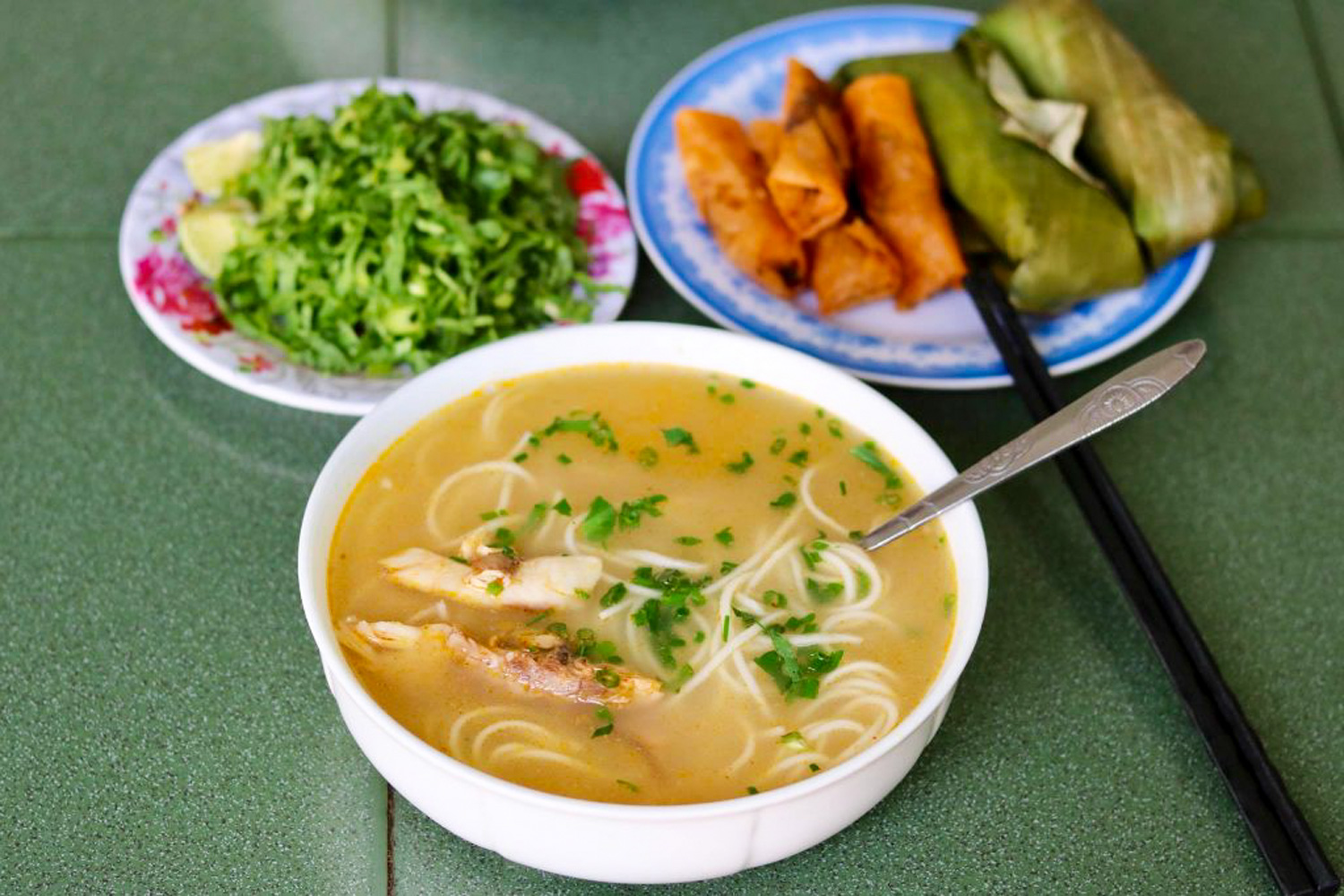
Snakehead fish porridge (Cháo sát)
In addition, Quang Binh is also famous for its dish Chao Sát made with wild snakehead fish. This dish is commonly known by different names such as Cháo Canh, Bánh Canh, and Cháo Vạt Giường, and has been around for a long time in the North Central region.
Snakehead Fish Porridge is made from fresh wild snakehead fish which is deboned and the flesh is used to create the broth for the porridge. The combination of the sweet flavor of the fish broth and the chewy texture of the snakehead fish creates a harmonious balance of taste and texture when enjoyed.
To cook a quality pot of Cháo Sát with snakehead fish, ingredients such as brown rice and red rice are needed. First, the rice is soaked for the appropriate amount of time and then ground into a fine powder. The rice flour is then kneaded thoroughly to achieve good elasticity, and the dough is pounded until it reaches the right “cooked flour” texture – firm, chewy, and not sticky to the hands.
After that, cooks will cut the rice dough into small pieces and use a pestle or a glass bottle to roll it out thinly to form strands. The next step is the “sat” process, which is the origin of the name Snakehead Fish Porridge. The smooth, soft dough is then sliced into small strands right in front of the customers and dropped into boiling water. This step is usually performed just before serving to ensure the noodles stay fresh and delicious. With such meticulous and delicate steps, Snakehead Fish Porridge with snakehead fish is a must-try specialty of Quang Binh.
Dried sweet potato (Khoai deo)
Quang Binh is a hot and sunny region that often faces natural disasters, such as flooding. However, this climate is ideal for the growth of sweet potatoes. For a long time, sweet potatoes have been a staple food during the flood season for residents. To ensure a supply of convenient food during the floods, various types of food, including sweet potatoes, need to be preserved for long-term use. The locals came up with the idea of drying the sweet potatoes to extend their shelf life. Interestingly, after being dried, the sweet potatoes take on a much richer and more delicious flavor. Thus, the specialty Khoai Deo (dried sweet potatoes) of Quang Binh was born.
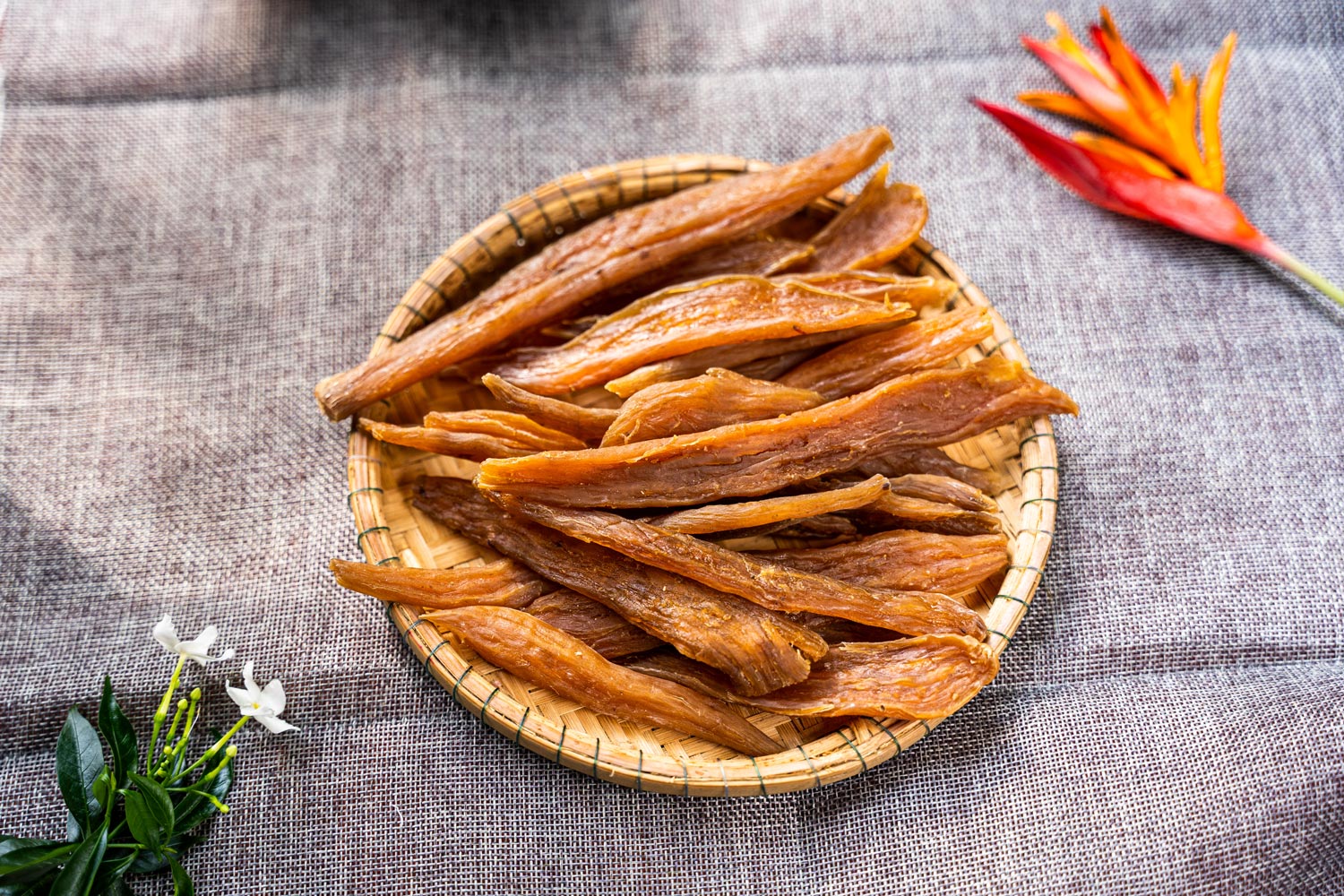
Dried sweet potato mainly originates from Hai Ninh Commune, Quang Ninh District, Quang Binh Province. The red sweet potatoes are grown on the white sands of this region. This is why this food has a distinctive flavor, richer and sweeter than sweet potatoes from other areas. The process of making is not overly complicated, yet the natural flavor of the sweet potato is preserved. The locals collect the sweet potatoes after harvest, allowing them to dry without sprouting. Then, the sweet potatoes are sliced into thin pieces and sun-dried for 7 to 9 days, resulting in chewy, sweet, and fragrant slices of sweet potato.
When you take a bite of dried sweet potato, you’ll experience the sweet, rich, and chewy texture of the sweet potato. You can enjoy each slice of Khoai Deo while sipping on a hot cup of tea. This speciality is a favorite snack for many, especially children. It should be stored in a dry, airtight container. If you prefer the Khoai Deo to be softer when eating, you can steam it in a rice cooker or microwave.
Seafood
With its coastal location, Quang Binh is home to a variety of fresh seafood. From fish, shrimp, and crabs to oysters and scallops, you can enjoy fresh seafood dishes or prepare them in many different ways. These seafood dishes are often prepared in unique and creative ways, showcasing the fusion of the sea and the land. When visiting Quang Binh, tourists can enjoy these enticing and distinctive seafood dishes at local restaurants and eateries. Notably, moulin crab soup with gourd (Canh cua bí đao) is one of the delicious dishes in Quang Binh. This dish is typically made with fresh crabs combined with gourd, creating a sweet, light flavor that is rich in nutrients.
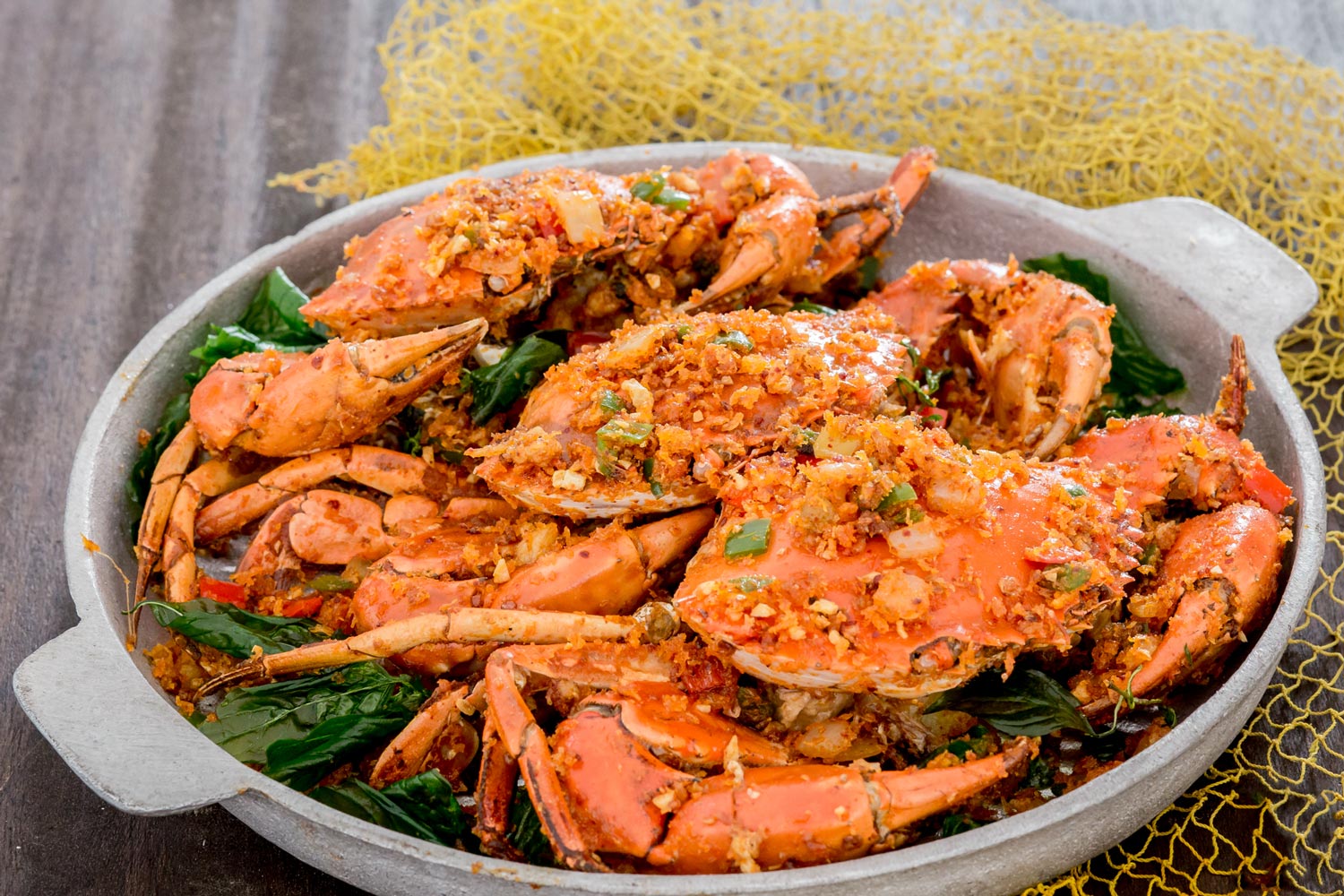
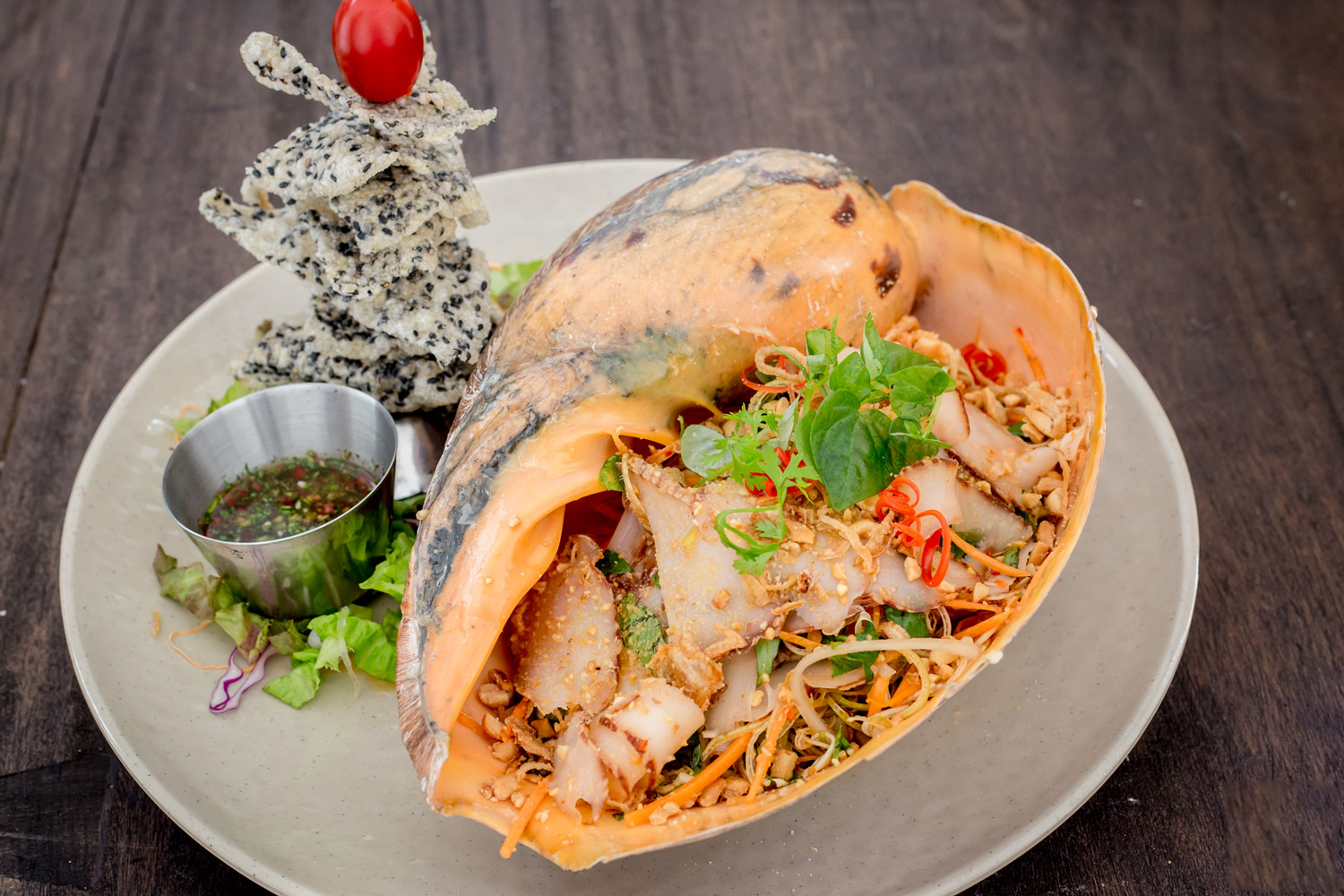
The delicious and unique seafood dishes in Quang Binh are often prepared by different methods such as grilling, steaming, stir-frying, or hot pot dishes. Among them, seafood hot pot is a popular dish in Quang Binh. It typically includes a variety of seafood such as scallops, crabs, squid, shrimp, clams, fish, and blue crabs, which are either dipped in or cooked in a flavorful hot pot with vegetables and seasonings, creating a delicious and nutritious meal. Additionally, if visitors have the chance, they can try some other attractive and famous local dishes of Quang Binh, such as jumping squid, stir-fried mussels, sour braised fish (cá đưng um chua), grouper salad, mackerel, cactus soup, etc. Many visitors have remarked that the fresh squid in Quang Binh is unmatched anywhere else.


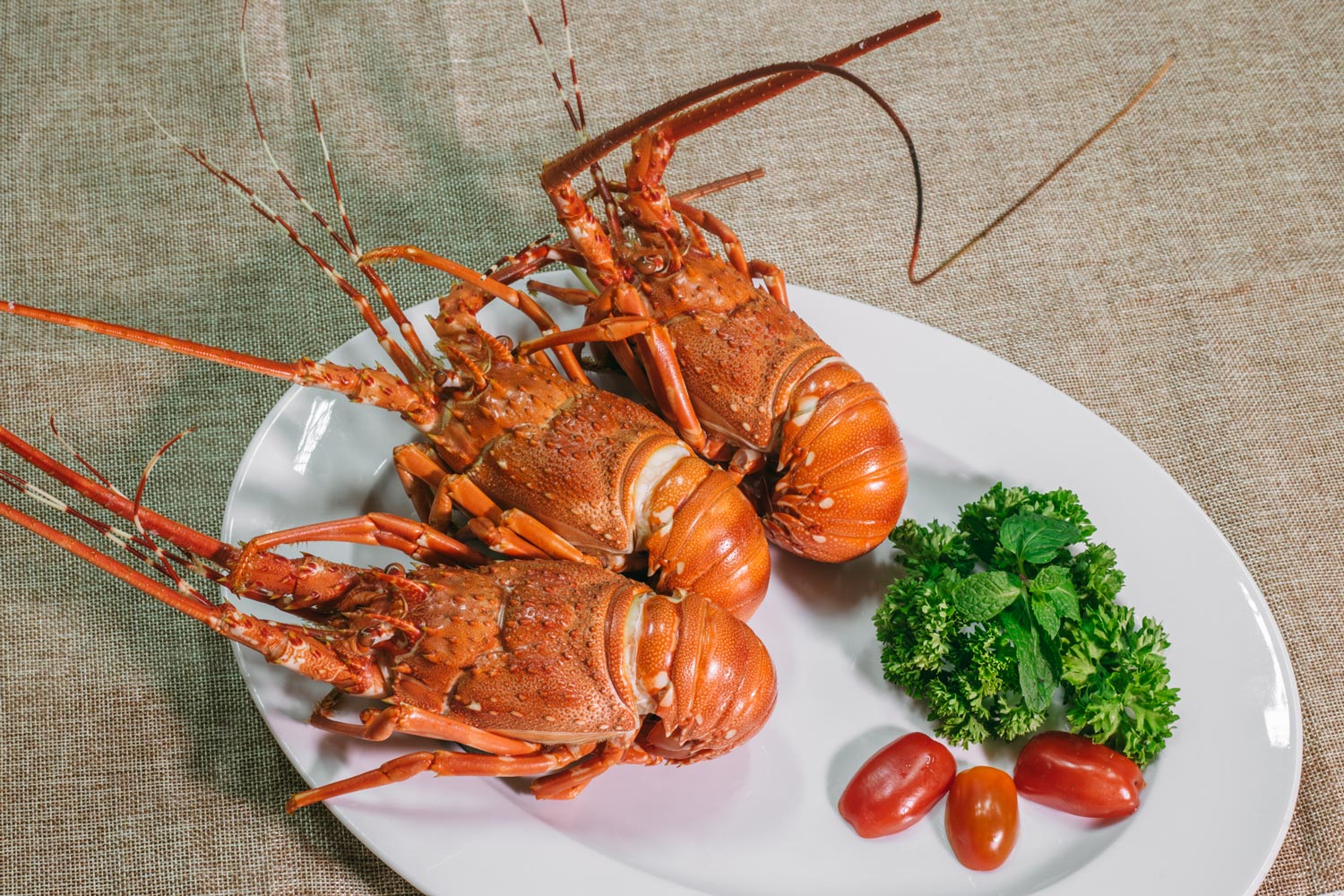
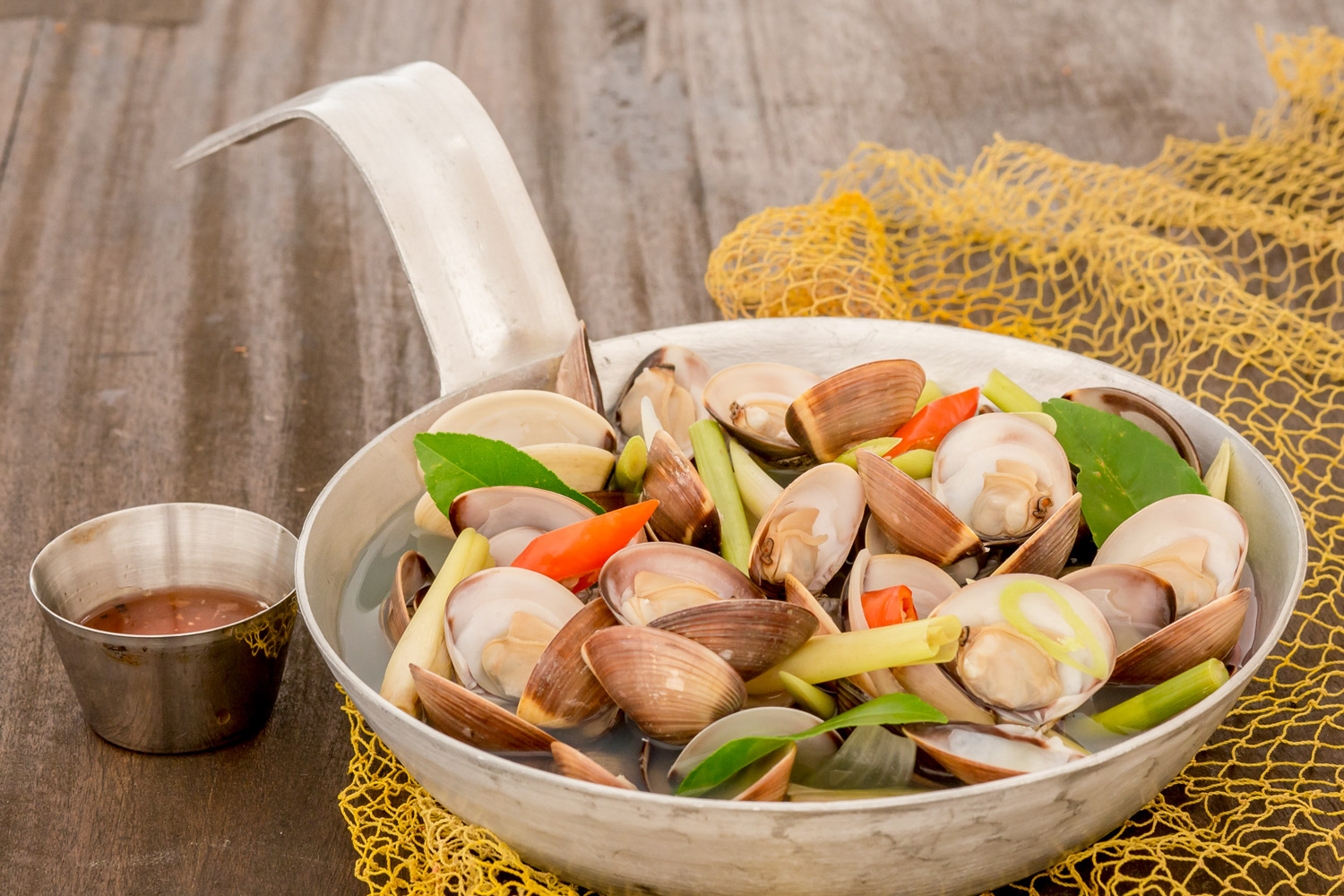
Oyster porridge
Quang Binh oyster porridge originates from Quan Hau town, a coastal town in Quang Ninh district, Quang Binh province. Oysters here are considered some of the best in Vietnam thanks to its firm and sweet-smelling meat. It is farmed in brackish water with the right level of salinity, rich in minerals and silt. Additionally, the oysters are raised naturally without the use of growth stimulants, ensuring high quality and food safety.
Oysters in Quan Hau town can be prepared in many delicious and attractive dishes such as grilled oysters, steamed oysters, fried oysters, stir-fried oysters, and oyster porridge, etc. To make a tasty oyster porridge, it is crucial to choose large fresh oysters with firm meat and intact shells. After being cleaned, the oysters are lightly stir-fried with onions, chili, and pepper to bring out their fragrance. The rice is soaked in water for about 30 minutes before cooking to ensure it cooks evenly and quickly. Typically, both sticky rice and regular rice are used to make oyster porridge. The sticky rice adds a rich, creamy flavor, while the regular rice helps create a smooth consistency. The usual ratio of sticky rice to regular rice is 1:1. After the porridge is fully cooked, the lightly stir-fried oysters are added to the pot, and seasonings are adjusted to taste.
When eating oyster porridge, you will experience the sweet and rich flavor of the oyster meat, the fragrant taste of the porridge, and the spices. The lovely and rich taste of the oyster meat is the highlight of this dish. The fresh oysters, with their natural sweetness, blend perfectly with the creamy flavor of the sticky rice, creating a very enticing taste. Additionally, oyster porridge is often served with chopped scallions, Vietnamese coriander, fresh chili, and chili fish sauce.
Tapioca dumplings (Bánh bột lọc)
Quang Binh’s tapioca dumplings are typically made from simple, easy-to-find ingredients such as tapioca flour, shrimp, pork, wood ear mushrooms, shiitake mushrooms, etc. The outer layer of the dumpling is made from tapioca flour, which has a moderate chewiness—not too hard, nor too soft. To make this food, tapioca flour is mixed with water in a 1:1 ratio. The mixture is then stirred until it thickens to a moderately sticky consistency. A bit of oil can be added to prevent the dumplings from sticking together.
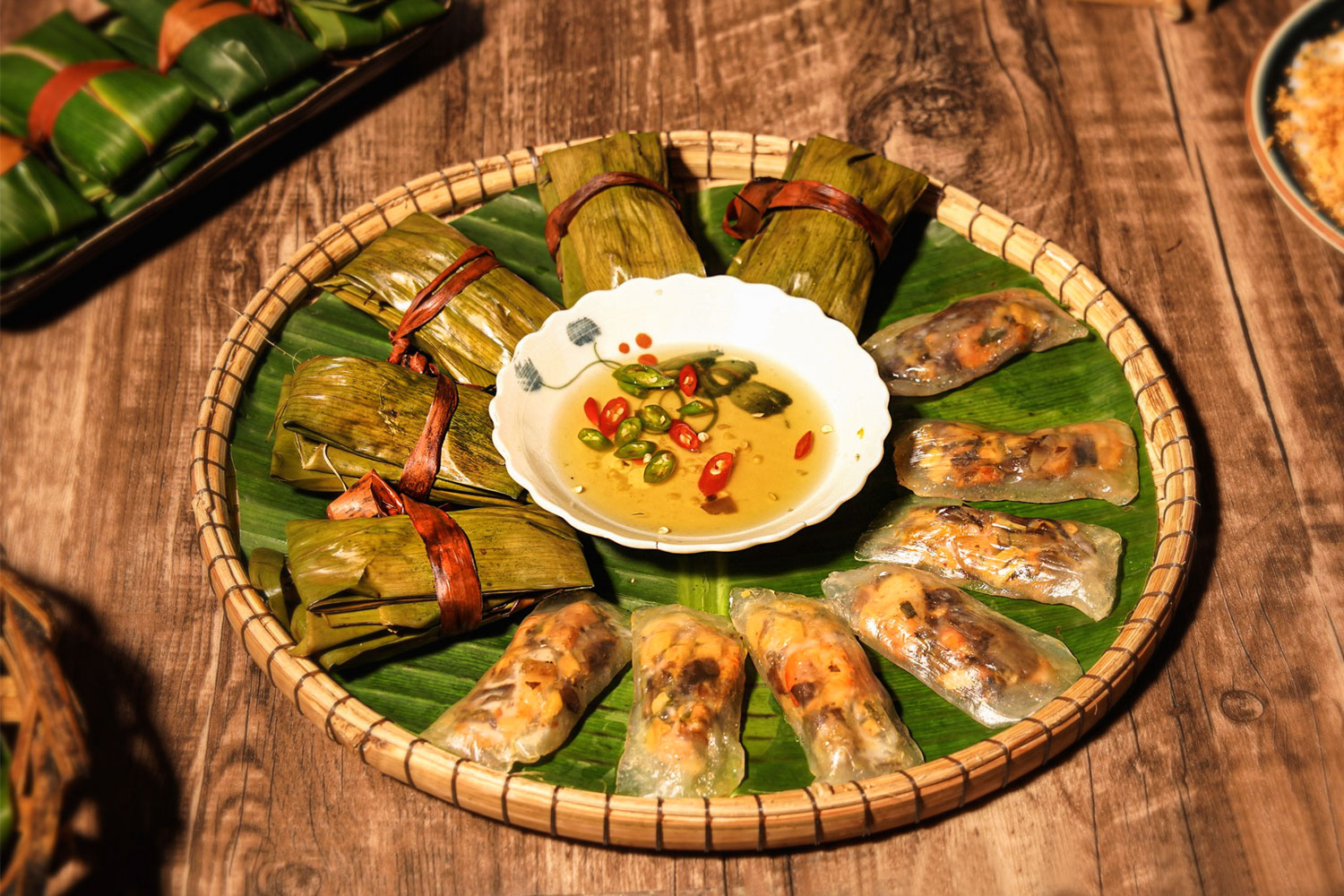
The filling of tapioca dumplings is made from shrimp, pork, wood ear mushrooms, shiitake mushrooms, etc., and is seasoned with rich spices, creating a harmonious blend of sweet, salty, sour, and spicy flavors. Quang Binh tapioca dumplings are commonly divided into two popular types: tapioca dumplings wrapped in banana leaf (bánh lọc lá) and steamed tapioca dumplings (bánh lọc trần). The distinctive feature of this dish lies in the thin, smooth, chewy outer layer, the flavorful shrimp and pork filling, and the sweet, sour, and spicy dipping sauce. When eaten, you can taste the sweetness of the shrimp, the richness of the pork, and the sweet-sour flavor of the dipping sauce, making it an incredibly enticing dish.
Making this dish is a delicate process that requires skill and dedication. From preparing the ingredients to wrapping the dumplings, each step demands precision and technique. Through traditional methods, Quang Binh’s tapioca dumplings have become an essential part of the local cuisine, as well as a popular specialty that tourists from all over the world would like to try.
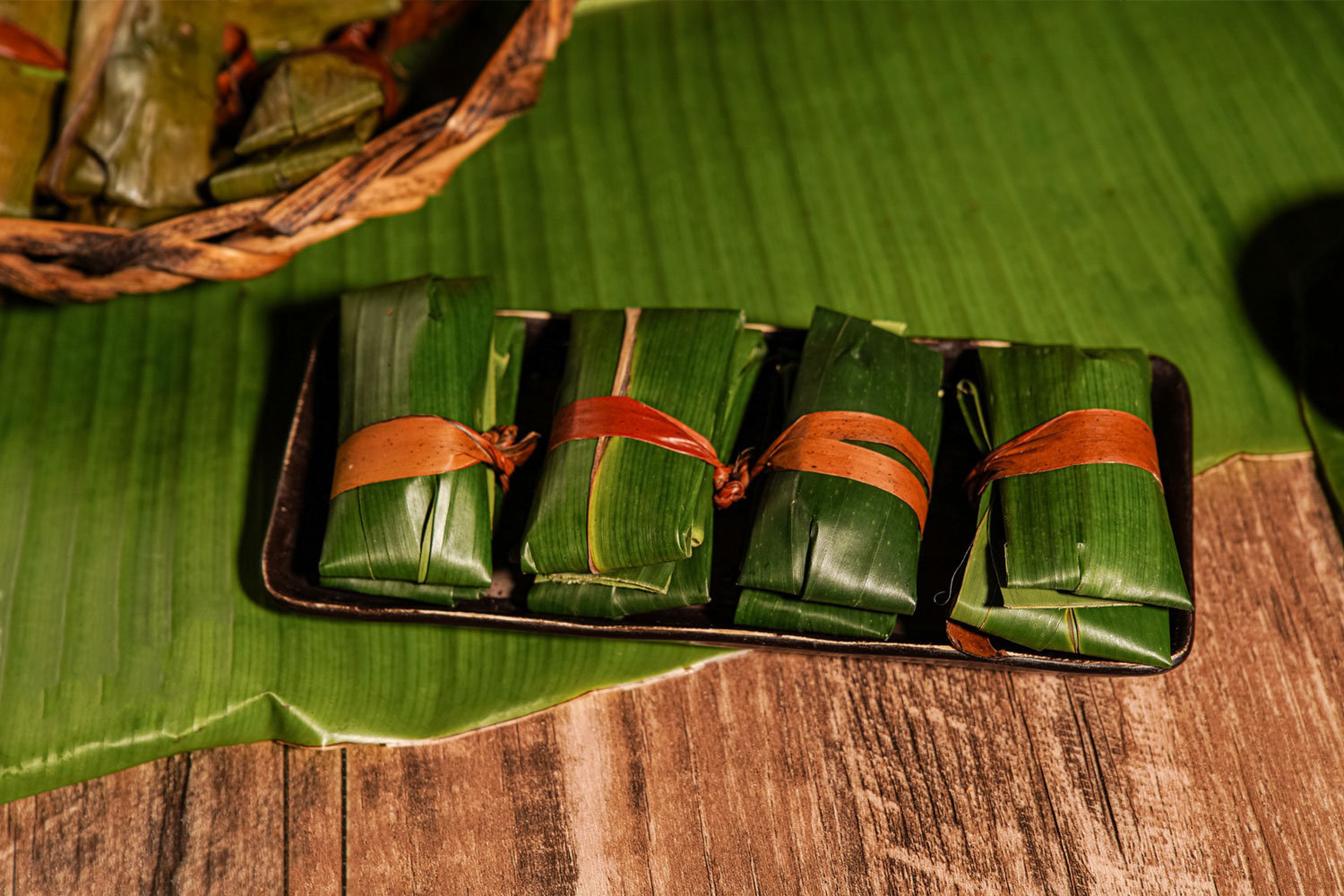
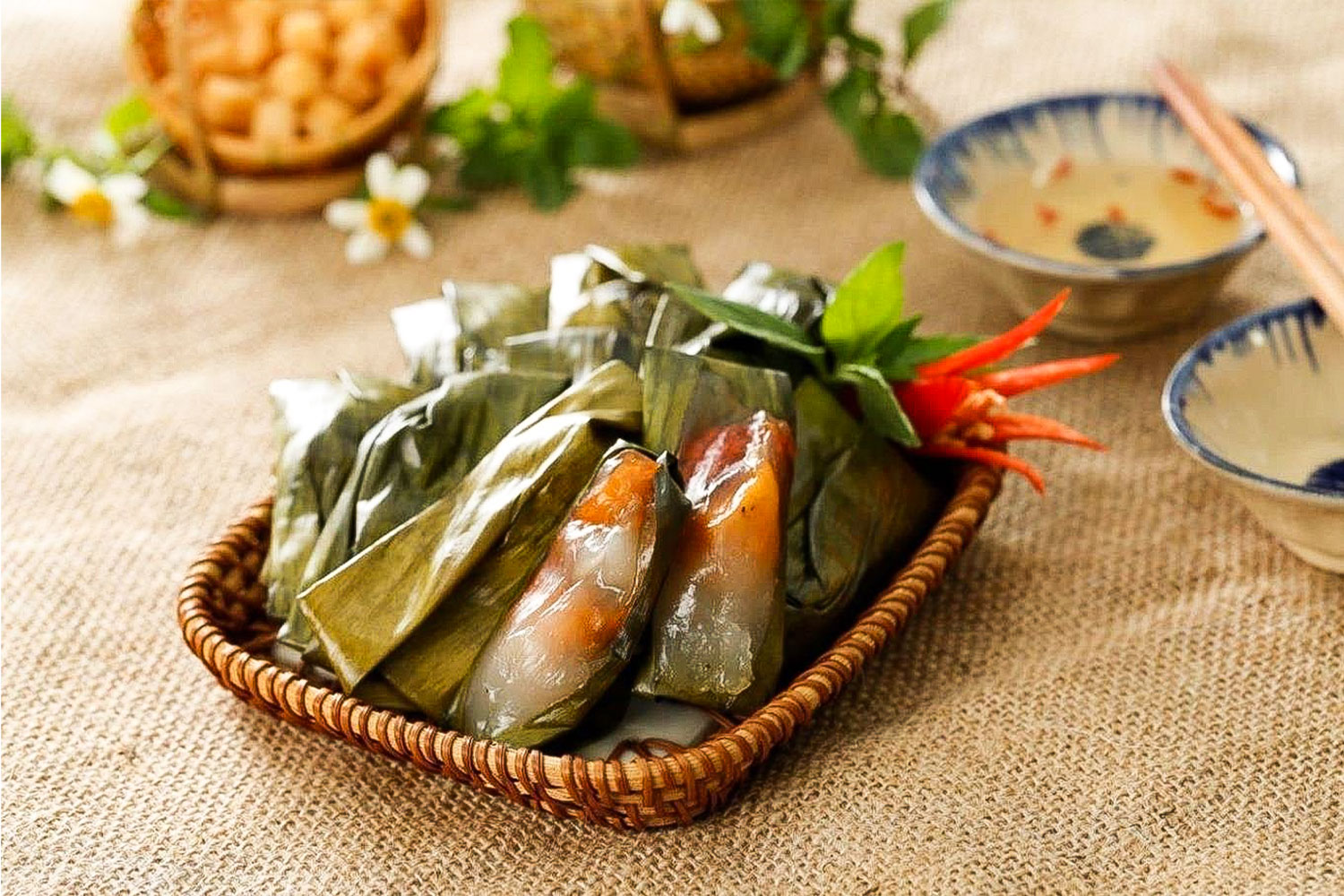
Grilled chicken with cheo salt
Grilled chicken with cheo salt is a traditional specialty of Quang Binh. What captivates visitors when enjoying this dish is the combination of crispy, smoky-flavored chicken and the unique taste of cheo salt. Grilled chicken with cheo salt is made from free-range chickens, which are raised in open fields, so when grilled over fire, the chicken retains its natural chewy sweetness without the need for excessive seasoning.
Cheo salt is a unique seasoning of Quang Binh, made from basil, lime leaves, salt, and green chili. Cheo salt has a fragrant, spicy flavor that enhances the dish, making it more savory and enticing. When eating grilled chicken with cheo salt, people usually tear the chicken into small pieces, dip it into the cheo salt, and enjoy. The chicken skin is golden and crispy, the meat is chewy and delicious, and the cheo salt is fragrant and spicy, creating an incredibly appealing taste.
Grilled chicken with cheo salt is often served with sticky rice. The sticky rice is soft and fragrant, blending perfectly with the spicy aroma of the cheo salt and the chewy, delicious chicken meat, creating an incredibly enticing flavor. In addition to its wonderful taste, grilled chicken with cheo salt also embodies the spirit and identity of the people of Phong Nha–Ke Bang. It is not just a tasty dish but also a part of the unique culinary culture of this region, enriching the culinary experience for visitors.
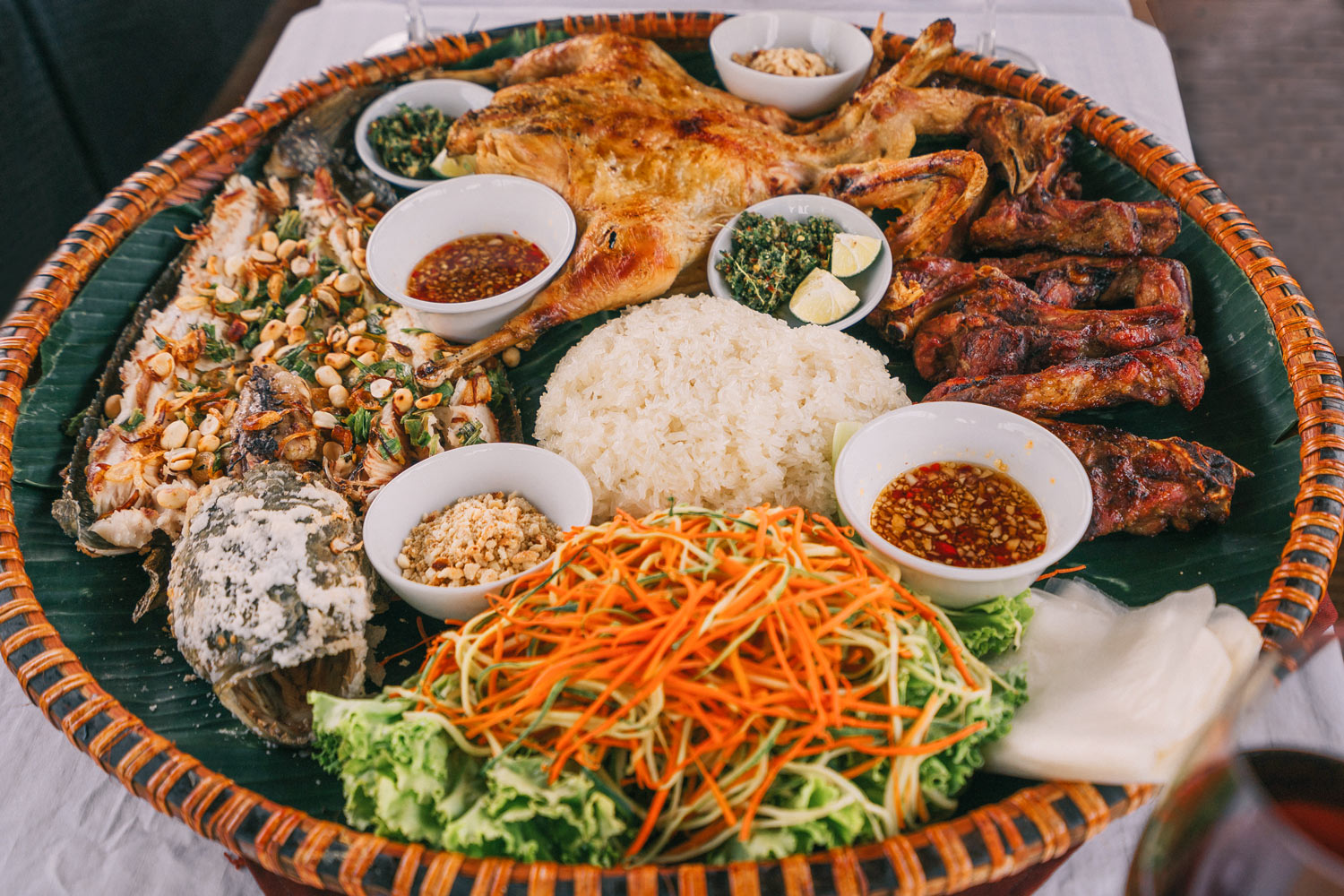
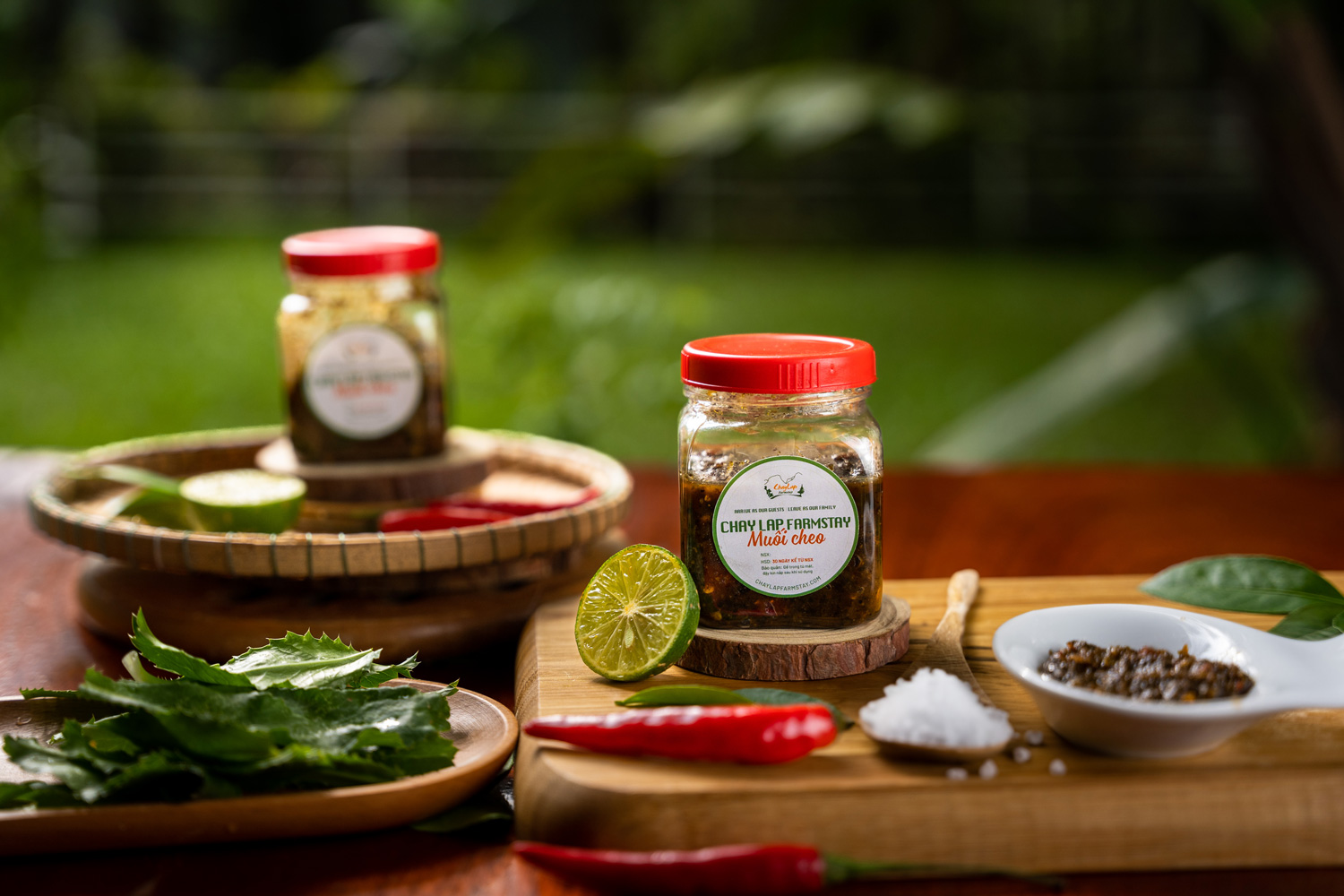
Steamed rice cakes with shrimp flakes
In the journey to explore Central Vietnam, visitors have certainly had the opportunity to try steamed rice cakes with shrimp flakes (Bánh bèo tôm chấy). However, when it comes to the rich and unforgettable flavor, nothing can compare to the steamed rice cakes of Quang Binh.
To make delicious Quang Binh steamed rice cakes with shrimp flakes, people usually use high-quality rice, finely ground into flour. The flour in Quang Binh has a moderate consistency—not too runny nor too thick. The flour is then poured into molds and steamed until cooked. The shrimp flakes are made from fresh shrimp, boiled, mashed, and stir-fried with scallions and seasonings. The crispy pork fat is made from pig fat and fried until golden and crispy.
The steamed rice cakes are white, thin, and smooth, topped with golden shrimp flakes, neatly arranged on a plate with a bowl of rich fish sauce. Despite having such simple ingredients, when you take a bite of steamed rice cakes with shrimp flakes, you immediately sense the irresistible appeal of this dish. It is a humble yet incredibly delicious dish that is not only a popular breakfast in Quang Binh but also a favorite among many tourists visiting this region.
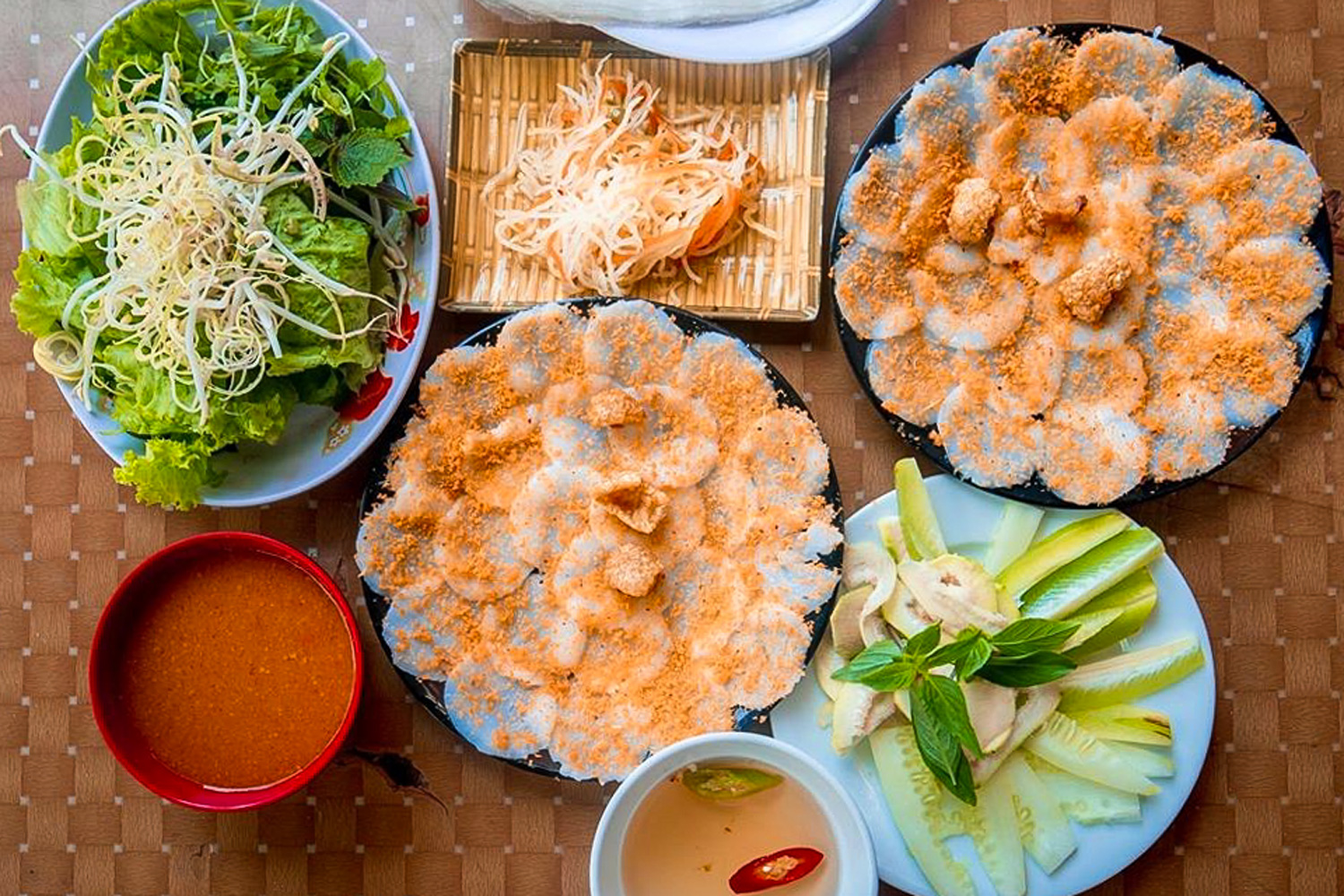
Bo Chinh ginseng
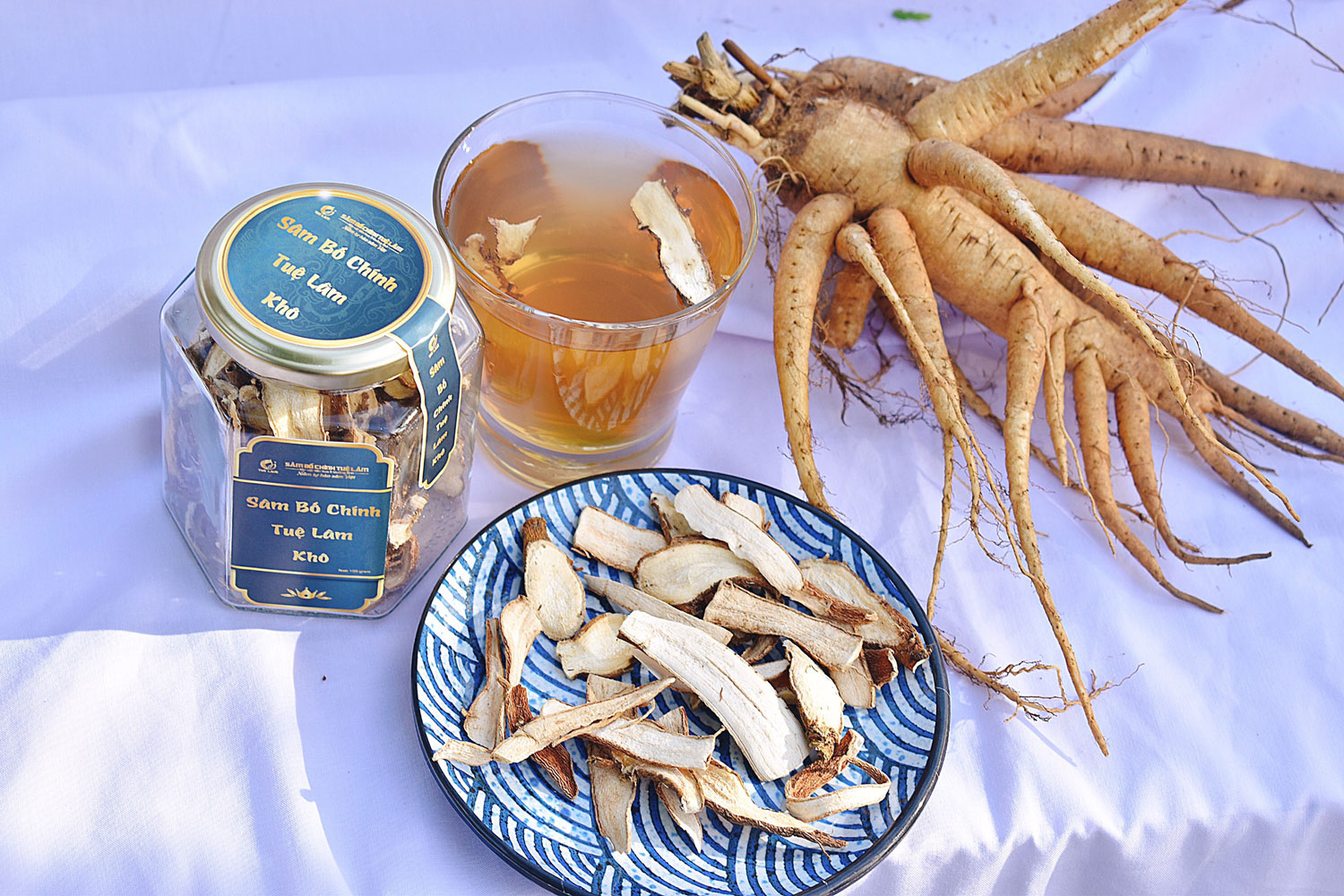
Bo Chinh ginseng is a plant in the mallow family, scientifically known as Abelmoschus sagittifolius. This plant has a long history and originates from Quang Binh, a province in Central Vietnam. Bo Chinh ginseng is also known by various names such as thổ hào sâm (local ginseng), sâm núi (mountain ginseng), and sâm khu năm, and it is renowned for its uniqueness and medicinal value.
The Bo Chinh ginseng plant has been present in Quang Binh for approximately 300 years, and in the past, it was used as a precious offering to the king. The name “Bố Chính” may originate from the fact that this ginseng was first discovered and used as a medicinal herb by the people of Chau Bo Chinh, now the areas of Bo Trach, Quang Trach, in Quang Binh.
Bo Chinh ginseng is considered a precious medicinal plant comparable in quality to Korean ginseng, with high nutrient content and significant nutritional value. Combining a long historical tradition, medicinal properties, and distinctive cultural significance, Bo Chinh Ginseng has become a rare and indispensable specialty symbol in the journey of exploring the culture and cuisine of Quang Binh. With its benefits of boosting health and improving blood circulation, Bo Chinh ginseng is an ideal gift for the elderly.
Nhat Le sea snake
Nhat Le sea snake is a unique and enticing specialty of Quang Binh. The sea snake, known locally as “đẻn,” is a slender and elongated body, typically measuring between 1 and 2 meters in length. It has a scaly body with striped, rough-textured skin. There are various types of sea snakes, such as đẻn kim (needle snake), đẻn cá (fish snake), đẻn sọc (striped snake), đẻn bông (flower snake), and đẻn gai (spiky snake). Each type, when cooked, offers a distinct aroma and sweetness.
The primary source of high-quality sea snakes is Nhat Le Beach, one of the most beautiful and renowned spots in Quang Binh. This sea snake specialty from this coastal area serves as the main supply for local restaurants and eateries. Nhat Le sea snakes are typically caught at night when they surface for air. To catch sea snakes, fishermen usually use nets or fishing lines.
Sea snakes are prepared into various dishes, with the most popular being snake blood liquor (rượu huyết đẻn), sea snake porridge, sea snake stewed with lemongrass and chili or Chinese medicinal herbs, minced sea snake served with rice crackers, sea snake rolls, grilled sea snake wrapped in betel leaves, and sea snake spring rolls (ram đẻn). Among these, sea snake spring rolls is the most distinctive dish made from Nhat Le sea snakes. The sea snake is thinly sliced, marinated with spices, wrapped in rice paper, and deep-fried to a golden crisp. The ram đẻn dish boasts a delicious, rich flavor that is highly enticing.
Roon River blood cockles
The Ron River, located in Quang Trach District, Quang Binh Province, originates from Dong Mua Mountain. Roon River blood cockles have become a unique culinary symbol of this region, captivating many visitors when they come to Quang Binh. What makes them special is that only here do blood cockles achieve their most delicious and rich flavor. The primary reason is that this area is where two water sources meet—the fresh water from the Vuc Tron Dam merges with the salty water from the East Sea.
The harvest season for Roon River blood cockles typically takes place from April to June each year. This is when the cockles are fully mature and at their most flavorful. The blood cockles from the Roon River have firm, sweet, and fragrant meat, offering a unique and enticing taste to dishes made from this seafood delicacy.
Roon River blood cockles can be prepared in various ways. One of the popular and unique preparation styles is blood cockles with lime (sò huyết tái chanh) and blood cockles with fish sauce (sò huyết chần nước mắm). The cockles are cleaned, shelled, and then drizzled with lime juice. Blood cockles with lime have a sweet and rich taste from the cockles, combined with the tangy flavor of lime, making it very appealing. Grilled with scallion oil (Nướng mỡ hành ) is a simple yet delicious dish. The cockles are grilled over hot coals and then brushed with a layer of scallion oil. Grilled cockles with scallion oil have a sweet, rich flavor and aromatic fragrance of the scallion oil.
In addition, Roon River blood cockles can also be prepared into many other dishes, such as stir-fried with garlic and chili, or stir-fried with tamarind,etc.
Bau Sen fish porridge
Bau Sen fish porridge is a famous specialty of Quang Binh, closely associated with the Bàu Sen freshwater lake located in Sen Thuy commune, Le Thuy district, Quang Binh province. The Bau Sen Lake area creates a poetic and peaceful scene, with its clear blue water and white sandy hills surrounding it, forming a tranquil space for visitors to explore and enjoy delicious dishes.
To make Bau Sen fish porridge, people typically use a mix of sticky rice and regular rice cooked with fish broth. The fish is boiled, then the meat is separated, seasoned, and added to the porridge. When the porridge is done, green onions, Vietnamese coriander, and pepper are added to enhance the flavor.
Without being labor-intensive or complicated in preparation, the Bau Sen fish porridge attracts diners with its freshness and rich, rustic flavors. The hot bowl of porridge makes the eater blow on it while savoring each bite, sometimes wiping away sweat but never stopping to enjoy the sweet and delicious fish pieces in the bowl. This dish has a fragrant, savory flavor and is often cooked with fresh herbs such as Vietnamese coriander, cilantro, and various other spices.
In addition to the famous fish porridge, the Bau Sen area also attracts visitors with its stunning natural scenery and peaceful atmosphere. Visitors can enjoy the relaxing environment, participate in fishing, or paddle boats on the lake. Furthermore, the area also has small eateries offering Quang Binh street food, providing a rich and interesting culinary experience for tourists.
Vo Xa wine
Vo Xa wine is a special product of the Quang Binh region, known for its unique flavor and cultural significance. Produced in Vo Ninh commune, Quang Ninh district, Va Xa wine is a delicate blend of pure water from the Cat Trang Cave and local rice. The traditional production method, with its unique fermentation process, creates a fragrant and strong wine that is unlike any other. The spicy, slightly sweet flavor of Vo Xa wine carries the essence of the coastal nature along with the distinctive aroma of rural rice.
Vo Xa wine is made from sticky rice, yeast, and pure spring water. To brew Vo Xa wine in the traditional style, the process involves a series of meticulous steps. First, the rice is washed clean and drained. Then, they use the pure spring water that is unique to Vo Xa to cook the rice. The rice is steamed with the spring water to form soft but not overly mushy rice. The rice is then spread out on a small mat to cool naturally in preparation for the next step of adding yeast. The yeast is taken out, crushed, and mixed with the cooled rice. The rice and yeast mixture is then placed in a fermentation container. After about three days, cold water is poured into the container to stimulate the fermentation process and turn the rice and yeast into wine. Finally, after this process, the wine can be extracted from the container, with approximately 5-6 liters being enough to enjoy the unique and fragrant Vo Xa wine.

Vo Xa wine is not only an interesting beverage but also carries the cultural and traditional values of the Quang Binh region. With its advantageous terrain and soil, Quang Binh has produced many famous agricultural products, and Vo Xa wine is considered a meaningful gift for visitors. If you have the chance to visit Quang Binh, trying a glass of Vo Xa wine is a wonderful way to experience the unique flavor of this land.
Bao Ninh fish sauce
Bao Ninh fish sauce is a famous specialty with a rich flavor from the Quang Binh region. Produced in Bao Ninh commune, Đong Hoi city, Bao Ninh fish sauce has become an essential part of the local cuisine and is highly regarded for its quality and taste.
Bao Ninh fish sauce is made from mackerel scad, a small anchovy that is about 10-15 cm long, with lean meat and plenty of oil. Mackerel scad is caught in the summer when the fish is at its fattest. Bao Ninh fish sauce is made using the traditional handcrafted method, from all-natural ingredients. The mackerel scad is cleaned, salted at a ratio of 5 parts fish to 1 part salt, and then fermented in wooden barrels for 12-18 months. Afterward, the fish sauce is filtered, bottled, and sold on the market.
Bao Ninh fish sauce has a golden color, a gentle fragrance, and a rich, sweet taste. It can be used as a dipping sauce for dishes such as boiled meat, braised fish, or boiled vegetables, or as an ingredient in cooking dishes like sour soup, and fermented fish noodles, or as a seasoning for many delicious dishes from Quang Binh.
Carrying the cultural and spiritual values of the people of Quang Binh, this product has become a culinary symbol of the coastal region where it is produced. Bao Ninh fish sauce also reflects the dedication and passion for preserving and developing traditional products, contributing to maintaining the local culinary heritage.
Phong Nha peanut oil
Phong Nha peanut oil is a pure product that is beneficial for health and has been trusted by many consumers. Made by pressing peanuts, Phong Nha peanut oil carries a rustic, hometown flavor, adding appeal to dishes. In an era where more and more products contain preservatives and harmful chemicals, pure Phong Nha peanut oil is a safe choice for consumers.
Phong Nha peanut oil is made using traditional methods and natural ingredients. The peanuts are harvested from the vast fields of Quang Binh and carefully sorted to remove any shriveled, moldy, or damaged seeds. Then, the peanuts are incubated with salt for 3-5 days to ferment, enhancing the flavor of the oil. After fermentation, the peanuts are placed in an oil press to extract the oil. The peanut oil is filtered to remove impurities, then bottled in glass containers and stored in a cool, dry place.
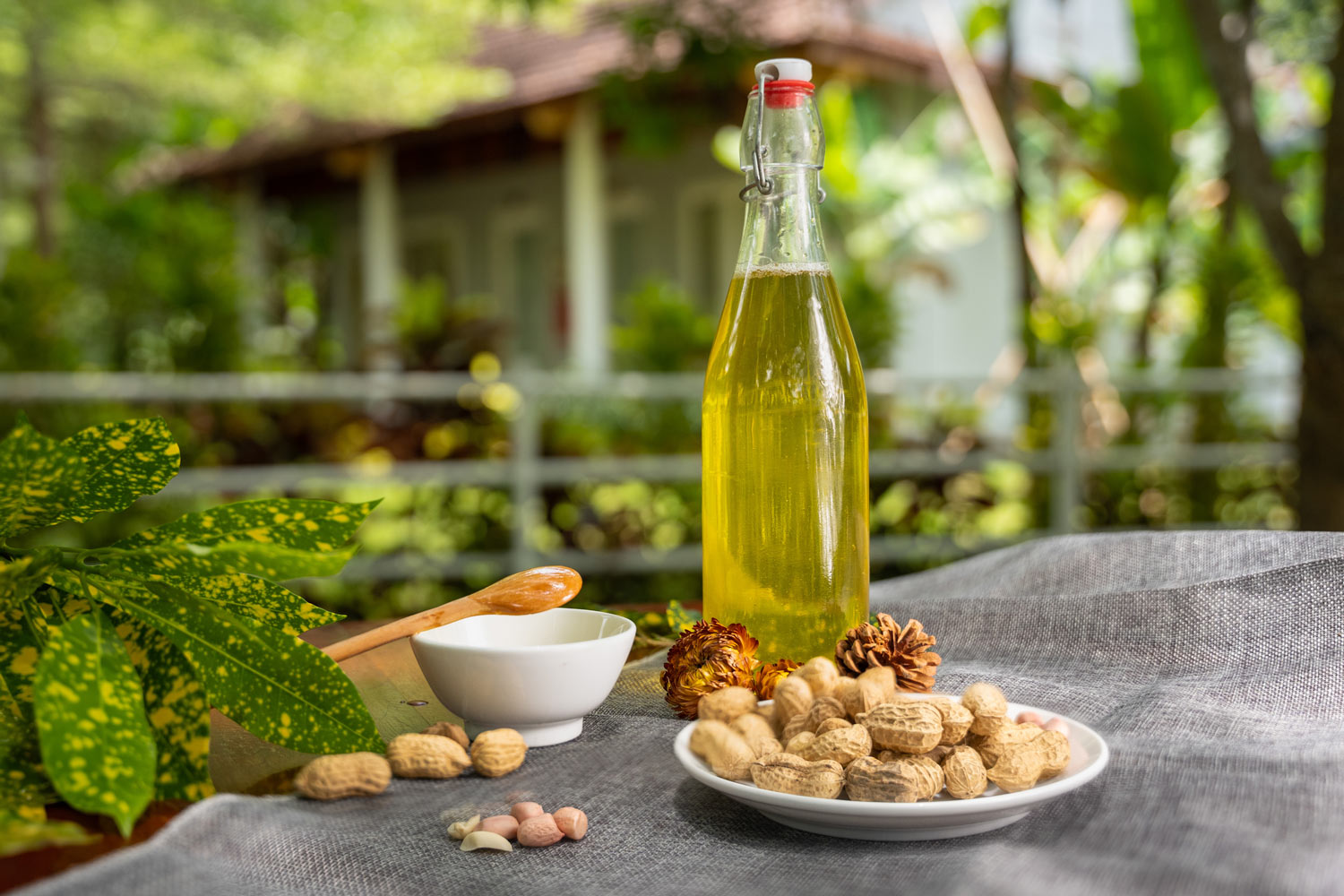
Phong Nha peanut oil is created through the process of pressing peanuts, retaining the natural flavor and nutrients of the peanuts. With a range of health benefits, Phong Nha peanut oil can be used for cooking, frying, grilling, or garnishing dishes. It can also be used in making natural cosmetics and skincare products.
Phong Nha peanut oil offers a delicious taste, thus reinforcing the brand and quality of the Quang Binh region. Choosing pure Phong Nha peanut oil also means supporting clean products and protecting the health of you and your family. If you have the chance to visit Quang Binh, don’t forget to try this peanut oil!
Quang Minh garlic
Quang Minh garlic is a unique and meaningful specialty of the Quang Binh region, particularly in Quang Minh commune, Ba Don town. Growing garlic for its bulbs is a traditional craft of the people in the Nam Quang Trach area (now Ba Don town).
The Quang Minh region, located in Ba Don town, Quang Bình, lies between two branches of the Gianh River and is known for its famous local garlic variety. Quang Minh garlic has a distinctive purple color, small but firm bulbs, and a strong aroma with a uniquely spicy flavor. Quang Minh garlic can be eaten raw, used as a seasoning for dishes, or given as a gift. It is grown on the fertile alluvial fields of Quang Minh commune and is cultivated using traditional methods. The garlic is harvested from November to April each year.
Garlic cultivation has brought a significant source of income to many households in the area. The story of growing and harvesting Quang Minh garlic is not only about economics but also reflects the determination and perseverance of the locals in overcoming challenges and innovating their livelihoods. With its unique flavor and high quality, Quang Minh garlic has become a meaningful gift after every trip and a nutritious food for health.
Hai Thanh shrimp floss
Hai Thanh shrimp floss (Ruốc Hải Thành) is a delicious and unique specialty of Quang Bình, closely associated with the Hai Thanh village in Dong Hoi City, Quang Binh province. The shrimp used in this dish are small marine mollusks, typically appearing in June in the waters of Nhat Le estuary, Dong Hoi. Locals often say, “June shrimp floss is dragon’s blood” (Ruốc tháng sáu là máu rồng), meaning that shrimp harvested in June are a rare and prized food, considered the best when collected during this time.
Fresh shrimp are typically processed through simple steps to create a dish called “ruốc quết” (shrimp floss). After placing the shrimp in a jar, the jar is wrapped in salt to preserve the shrimp for a longer period. Once the salt is evenly absorbed, the shrimp are squeezed dry to form shrimp powder. In addition, locals often crush the remaining shrimp shells, sift them, and dry them under the sun. Throughout the process, hygiene is always a priority to remove any impurities, grit, or sand.
The people of Hai Thanh village have passed down the tradition of making shrimp paste from generation to generation, preserving and developing the craft of shrimp processing, which has contributed to the enrichment of local livelihoods and the promotion of the local economy. Additionally, Hai Thanh shrimp floss has become a cultural and culinary symbol of the people of Quang Binh, carrying the special flavor and affection of the beautiful seaside village.
Suppose you want to experience the unique flavor of Hai Thanh shrimp floss from Quang Binh. In that case, you can visit local shops and markets such as Dong Hoi Market, Bac Ly Market, Nam Ly Market, Hoan Lao Market, Ba Don Market, Treo Market, and Quan Hau Market, etc. or check out stores that sell Quang Binh specialties to have the opportunity to taste and buy meaningful souvenirs from your trip. This is also the answer to the question, “Where can you buy Quang Binh specialties?”
Ma Coong’s stem liquor
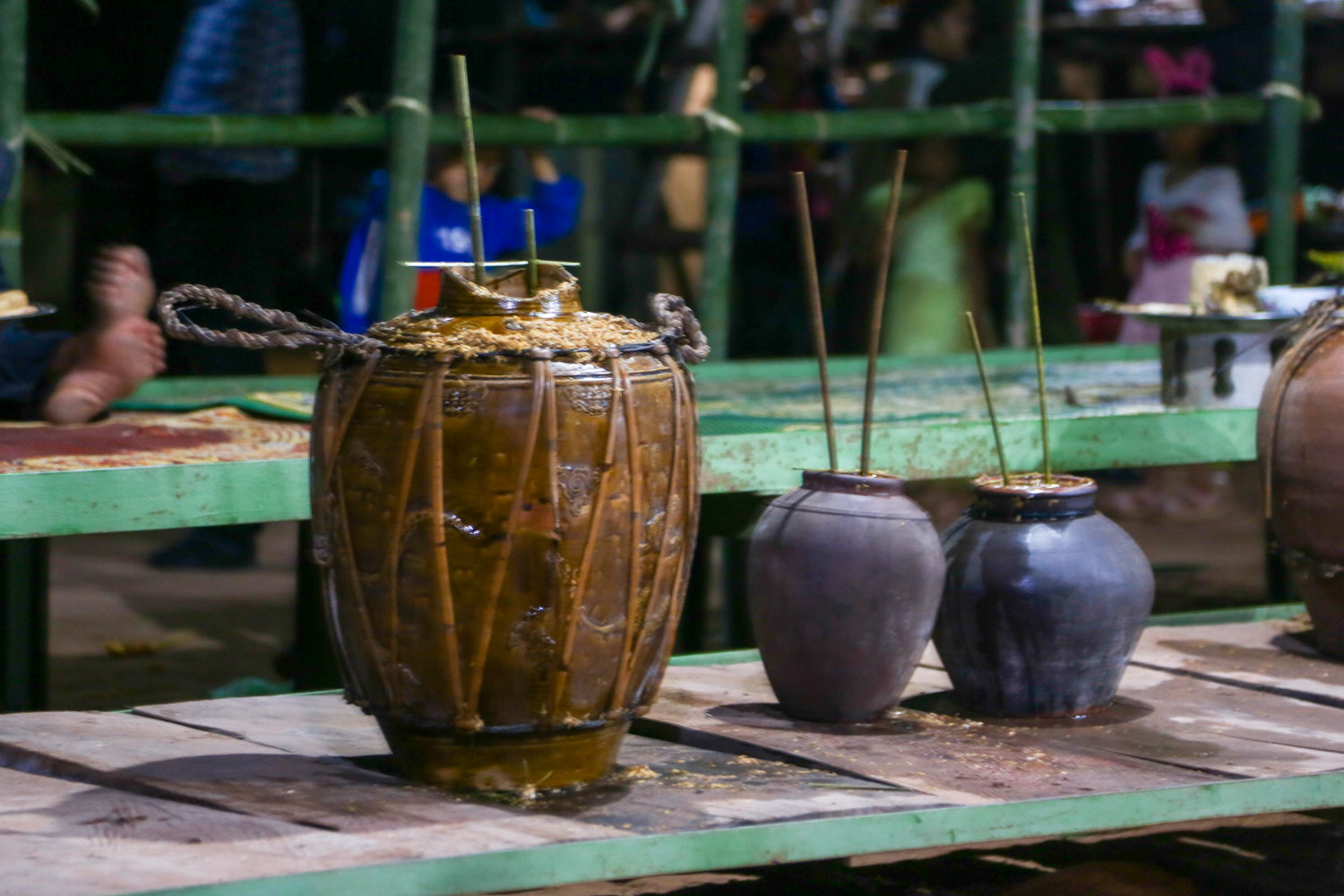
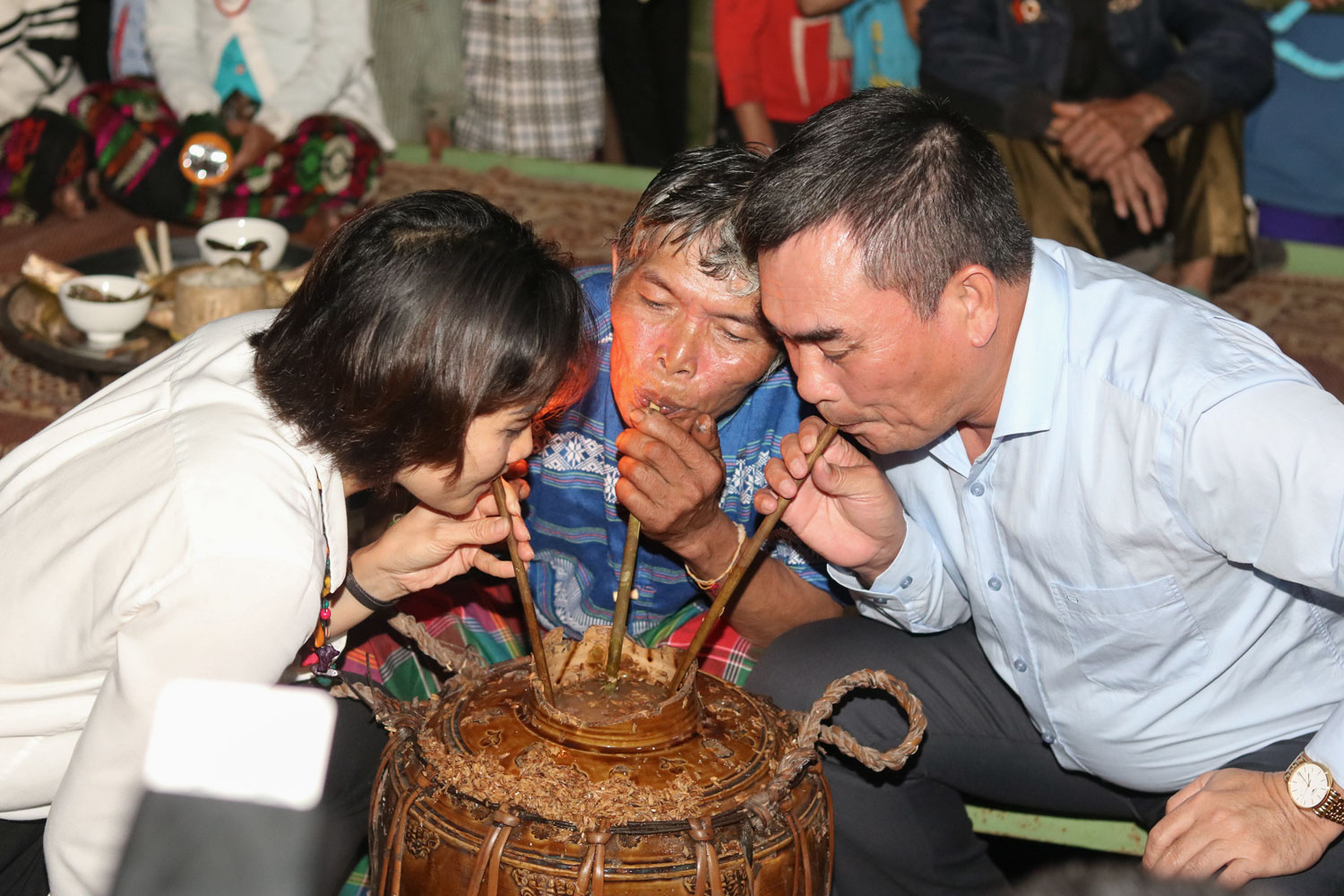
Ma Coong’s stem liquor is a part of the unique and distinctive culinary culture of the Quang Binh region. This wine is a specialty beverage that is fermented by some ethnic minorities in Vietnam in jars, bottles, large jars, or clay pots, without the distillation process. When consumed, people use bamboo or rattan straws with holes to drink stem liquor. Ma Coong stem liquor is typically served during religious ceremonies and village festivals, and to entertain guests.
In Quang Binh, Ma Coong’s stem liquor is an exemplary example of local specialty cuisine. It is an essential part of the culinary experience in this region. The traditional characteristic of the wine is the perfect combination of a light fragrance and a spicy taste, creating a unique experience for those who enjoy it.
In addition to enjoying Ma Coong’s stem liquor, visitors also have the opportunity to explore the traditional culture and festivals of the Ma Coong ethnic group in Quang Binh. One of the unique events is the “Drum Beating Festival” of the Ma Coong people, held annually on the 16th day of the first lunar month in Ca Roong village, Thuong Trach commune, Bo Trach district. This festival attracts people from the Ma Coong community as well as a large number of people from other ethnic groups in neighboring areas.
Ma Coong’s stem liquor is an important part of the unique culture and cuisine of Quang Binh, offering visitors a chance to experience its distinctive flavors and enjoy the rich culture and traditions of this region.
The Son river carp
The Son river carp is a symbol of Quảng Bình cuisine, characteristic of the Phong Nha-Ke Bang region. The Son River, winding around the Phong Nha limestone mountain range, has provided the locals here with a precious gift. This dish is an essential part of the journey to savor Quang Binh’s specialty foods.
The Son river carp is not only a delicious dish but also reflects the diversity and richness of local cuisine. The farming of giant carp has become a main livelihood for many households in Phong Nha town, Bo Trach. To meet the demand of tourists and increase the income for locals, the Xuan Son Agricultural and Ecotourism Development Cooperative has invested in developing facilities to serve this specialty dish of Quang Binh.

The fish are raised in clean, fast-flowing water, making the meat firm and delicious. The Son river carp can be prepared in many delicious ways, with the most popular being carp fish cakes, fried carp, and grilled carp. This dish is commonly served in restaurants and eateries around the Phong Nha-Ke Bang area. In addition to tasting the dish, visitors also have the opportunity to participate in activities related to the giant carp, such as the Son river carp festival, where locals and tourists compete and experience the thrill of catching fish quickly. The Son River Carp offers a unique culinary experience and provides a way to explore the distinctive food culture of Quang Binh while savoring its unique flavors.
The role of local specialties in Quang Binh’s culture and economy
Quang Binh’s specialties not only have culinary value but also play an important role in the local culture and economy. They are an essential part of tourism and provide income for the local people. These specialties are also a part of the cultural landmarks and help highlight the process of local economic development. Moreover, the prices of Quang Binh’s specialties are very reasonable, attracting the attention of tourists whenever they visit this region.
Symbols of identity and tradition
Local specialties often carry stories of history, traditions, and the way of life of each region. They reflect the creativity and spirit of the people, along with the preservation of traditional cooking methods and family recipes. Specialties are often associated with important events in life such as festivals, anniversaries, and traditional holidays. Through these specialties, people can share interesting stories, inspire others, and preserve cultural values across generations.
An important source of income for locals
Local specialties not only play a key role in culture but also contribute significantly to the local economy. They create income for locals and help promote tourism and local economic development. Famous specialties can become unique attractions for tourists from all over, driving growth in the tourism and related service industries.
In addition, the production and consumption of local specialties stimulate agriculture, livestock, and the production of agricultural products. This helps generate jobs, improve the income of local people, and promote sustainable development.
A bridge for cultural exchange
Local specialties act as a bridge for cultural exchange between regions and countries. When tourists enjoy a Quang Binh specialty, they also have the opportunity to learn about the culture, history, and customs of the region where the dish originates. In addition to the direct experience, Quang Binh’s specialties, when brought as gifts, become “cultural ambassadors” to share with others. The exchange and gifting of specialties open up opportunities for cultural interaction, creating moments for conversation, sharing experiences, and learning from one another. Specialties become a way to express admiration and respect for each other’s culture, creating strong connections between nations and ethnic groups.
Quang Binh’s culinary treasures offer more than just a meal—they provide a window into the region’s vibrant culture and natural abundance. From the fresh, flavorful taste of the sea to the rustic, earthy delights of the mountains, every dish tells a story of tradition, skill, and creativity. For food lovers and curious travelers alike, exploring these top 10 specialties is not just a culinary adventure but an unforgettable experience that captures the heart of Central Vietnam. As you savor each bite, you’ll not only taste the essence of Quang Binh but also carry home memories of its warm hospitality and unique charm.
Frequently asked questions?
What is the most famous specialty in Quang Binh?
Some of Quang Binh’s most famous specialties include Vietnamese noodle soup, snakehead fish porridge, dried seafood such as dried squid, tapioca dumplings, cactus soup, and steamed rice cakes with shrimp sprinkles.
These dishes are characteristic of the region, made from fresh ingredients that highlight the unique flavors of Quảng Bình’s coastal and mountainous areas.
What are the must-try specialties in Quang Binh?
When enjoying Quang Binh’s cuisine, you should not miss delicious dishes like dried sweet potato, Vietnamese noodle soup, fresh seafood, and Vietnamese pancakes.
- Dried sweet potato is a sweet and chewy snack, making it a perfect gift to bring home.
- Vietnamese noodle soup with a unique blend of meats and leafy vegetables, offers a delightful culinary experience.
- Fresh seafood, including squid, fish, and scallops will satisfy food enthusiasts.
- A crispy Vietnamese pancake filled with fresh ingredients will surely conquer your taste buds.
What Quang Binh Specialties Should You Buy as Gifts?
If you’re looking for a specialty gift from Quang Binh, consider options like chewy dried sweet potatoes, Bo Chinh ginseng, Hai Thanh dried shrimp floss, or Bao Ninh fish sauce. These will be delightful gifts for those who love traditional flavors and unique regional cuisine. Quang Binh’s specialties are also reasonably priced, making them accessible to a wide range of people.
Where to Buy Quang Binh Specialties?
You can visit local shops, local markets, or night markets such as Dong Hoi Market, Nam Ly Market, Hoan Lao Market, Ba Don Market, Trao Market, etc., or refer to Quang Binh specialty stores to enjoy and bring back meaningful gifts after your trip.
What Makes Quang Binh Cuisine Special?
Quang Binh cuisine embodies the authentic flavors of Central Vietnam, featuring delicious and captivating dishes that reflect both the mountains and the sea. Local dishes often use fresh ingredients such as fish, shrimp, squid, wild vegetables, and forest mushrooms, creating unforgettable flavors for visitors to enjoy.




